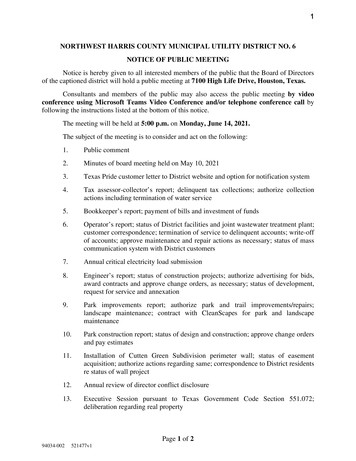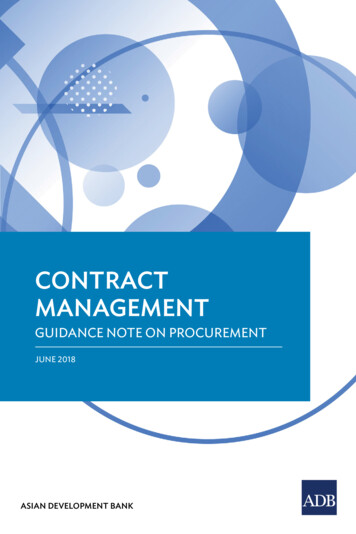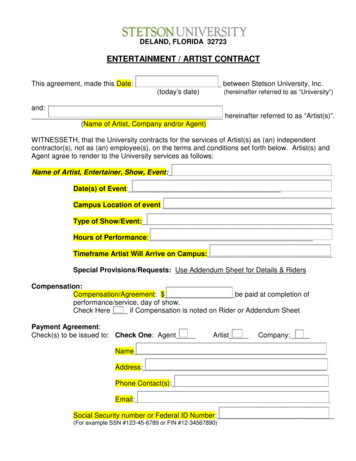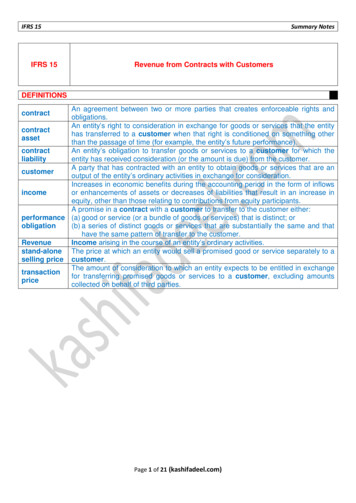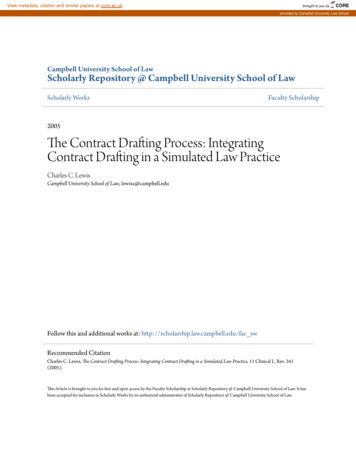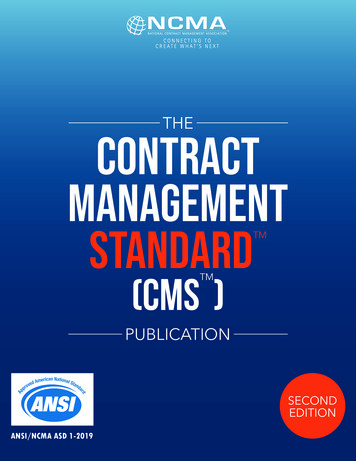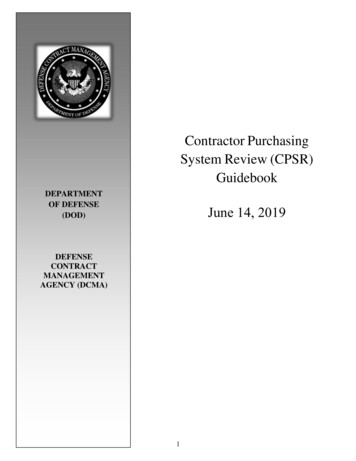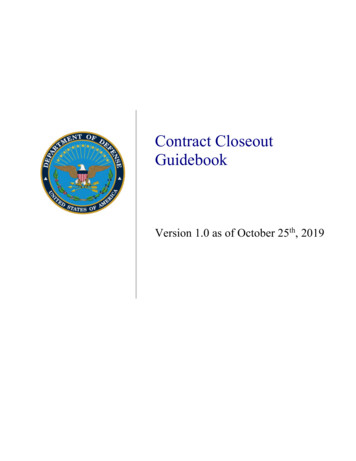
Transcription
Contract CloseoutGuidebookVersion 1.0 as of October 25th, 2019
Table of ContentsTable of Contents. 21 Purpose . 32 Preface . 33 The Contract Closeout Process . 43.1 When Does the Contract Closeout Process Begin? . 43.2 Types of Closeout . 63.2.1 Automated Contract Closeout . 63.2.2 Manual Contract Closeout. 8A. Procedures for Manual Contract Closeout . 93.3 Time Standards for Contract Closeout . 143.4 File Retention Period . 153.5 Responsibility for Contract Closeout . 153.6 Responsibility of the Procuring Office When Administrative Contract Closeout isPerformed by a Different Office . 153.7 Contract Closeout Reporting. 164 Appendices . 17Appendix A – Acronyms . 17Appendix B – Problems in Contract Closeout . 19Appendix C – DoD Class Deviation 2019-Quick Closeout Procedures Threshold . 25Appendix D – Contracting Officer’s Documentation for Using Quick Closeout Authority . 26Appendix E – Forms. 28DD Form 254 (April 2018). 28DD Form 882 (July 2005) . 28DD Form 1593 (April 1969) . 28DD Form 1594 (February 1970). 28DD Form 1597 (April 2000) . 28Appendix F – Sample Release of Claims and Assignment of Refunds, Rebates, and Credits . 29Appendix G – Chart of FAR/DFARS/PGI Closeout References . 31Appendix H – PIEE Closeout Tool Roles, Workflow, and Reports . 32Appendix I – AbilityOne Program . 34Appendix J – PIEE Closeout Reports . 36Contract Closeout Guidebook October 20192
1 PurposeThe purpose of this guidebook is to help Department of Defense (DoD) officials establish andmanage Contract Closeout. It provides an inventory of the pertinent polices and processes, with agoal of streamlining and consolidating guidance on Contract Closeout in a single easy-to-accessdocument.2 PrefaceContract Closeout is the final action taken on each DoD acquisition and establishes that eachparty has fully satisfied its obligation to the other. The contractor must have delivered everythingthe contract required (material, services, data, certifications, etc.) and the Government must havepaid the contractor in full. Any excess funds on the contract must have been de-obligated.Property rights, both physical and intellectual, must have been settled to the satisfaction of theparties. Administrative actions must have been finalized, all necessary documentation must havebeen included in the contract file, and a Contract Completion Statement must have beengenerated. These Contract Closeout requirements can be found in Figure 1 below:Requirements for Contract CloseoutAll parties havefully satisfiedobligations tothe other(s).All contractrequirementshave beendelivered.Governmenthas paidcontractor infull.All excess fundson the contracthave been deobligated.Property rightshave beensettled to thesatisfaction ofall parties.Administrativeactions havebeen finalized.Alldocumentationhas beenincluded in thefile.ContractCompletionStatement hasbeengenerated.Figure 1Timely Contract Closeout is important because without this final step in a contract’s life cycle,the Government cannot settle its financial records. Unliquidated balances, the funds remainingon a contract after performance has ended, can result in not identifying improper payments in atimely manner, or in the inability to reuse excess unspent funds elsewhere.Even though Contract Closeout is important, it is often given a low priority by most contractingactivities because efforts are focused on new contract awards so that end users can receive thegoods and services needed to meet mission requirements. As a result, Contract Closeout isgenerally seen as an organizational weakness and often the subject of audit investigations andreports within the Department.The closeout process can be simple or complex depending on the contract type. ContractCloseout may require coordination between the procuring contracting office, payment office,field administration office, program office, auditing office, security office, general council, andContract Closeout Guidebook October 20193
the contractor. Proper contract construction, thorough contract and modification receipt andreview, and timely monitoring of funds status and potential for cancellation of funds, leads to aneasier and more efficient Contract Closeout process. Figure 2 includes the primary personnel andoffices that play a role in the Contract Closeout fficeFigure 2The purpose of this Contract Closeout Guidebook is to assist Contracting Officers with thisimportant effort. The Guidebook takes policy from across the Federal Acquisition Regulation(FAR), Defense Federal Acquisition Regulation Supplement (DFARS), Procedures, Guidance,and Information (PGI), and Financial Management Regulation (FMR) and places it in a singlereference. It does not address component specific policies and procedures for Contract Closeout.3 The Contract Closeout Process3.1 When Does the Contract Closeout Process Begin?The office administering the contract is responsible for initiating administrative closeout afterreceiving evidence of physical completion. Physical completion is defined in FAR 4.804-4 as: The contractor has completed the required deliveries and the Government hasinspected and accepted the supplies; The contractor has performed all services and theGovernment has accepted these services; and all option provisions, if any, haveexpired; ORThe Government has given the contractor a notice of complete contract termination.Contract Closeout Guidebook October 20194
Note: Facilities contracts, rental, use, and storage agreements are considered to be physicallycomplete when the Government has given the contractor a notice of complete contract termination;or the contract period has expired.Under Cost-Type or Time & Material (T&M)/Labor Hour (LH) contracts, , if the Governmentdoes not intend to provide additional money to the contract, because of the terms of theLimitation of Cost/ Limitation of Funds and Payments under the T&M and LH Contractsclauses, which specify that the contractor does not have to continue performance once its costsequal the established cost ceiling of the contract, the contractor does not have to deliver therequired supplies. Thus, under these types of contracts that contract should be consideredphysically complete once the cost ceiling is reached.Although a contract may be physically complete, other factors may delay the actual closeout. Forexample, if the final amount due to the contractor has not been determined or if there is anoutstanding claim by or against the contractor, the contract may not be closed even if it isphysically complete. Based on these considerations, a contract may not be closed until it isphysically complete, the amount owed to the contractor has been finally determined, and allclaims regarding the contract have been resolved. Contracts are administratively complete whenall administrative activities have been accomplished, any required releases executed, and finalpayments made.A contract should NOT be closed if:The contract is inlitigation or underappealThe contract is underThe contract has valueinvestigation orengineering proposalsinvolves a deferredpendingdebtThe contract isterminated and thetermination actionshave not beencompletedFigure 3Closeout of Basic IDC/BOA/BPA: When the ordering period in the basic Indefinite DeliveryContract (IDC), Basic Ordering Agreement (BOA), or Blanket Purchase Agreement (BPA) haslapsed, and no modification has been issued to extend the ordering period, the basic IDC, BOA,or BPA can be closed only when all orders issued against it have been closed.Contract Closeout of individual orders under IDC, BOA, or BPA’s should begin once the orderis physically complete.Continued Contract: PGI 204.1601 allows for a continued contract to be issued solely foradministrative reasons. The predecessor contract should be closed out when all inspection,acceptance, payment, and other closeout issues associated with supplies delivered and servicesperformed under the predecessor contract are complete.Contract Closeout Guidebook October 20195
3.2 Types of Closeout3.2.1 Automated Contract CloseoutAs permitted by FAR 4.804-5(a), Automated Contract Closeout (ACCO) allows a system toinitiate and execute the closeout action without action on the part of the Contracting Officeradministering the contract. ACCO is a capability that currently resides in PIEE.A contract qualifies for the ACCO process if it meets the criteria in Figure 5 below, which isoutlined in DFARS PGI 204.804-3:DFARS PGI 204.804-3 Requirements for Automated Contract CloseoutContract Type Firm-fixed pricedContract Value does not exceed 500,000 (inclusive of exercised options)Contract does not contain any of the following provisions requiring administrative action atcloseout:(A) FAR 52.211-11 Liquidated Damages—Supplies, Services, or Research and Development.(B) FAR 52.216-7 Allowable Cost and Payment.(C) FAR 52.227-9 Refund of Royalties.(D) FAR 52.227-11 Patent Rights—Ownership by the Contractor.(E) FAR 52.227-13 Patent Rights—Ownership by the Government.(F) FAR 52.232-16 Progress Payments.(G) FAR 52.232-29 Terms for Financing of Purchases of Commercial Items.(H) FAR 52.232-30 Installment Payments for Commercial Items.(I) FAR 52.232-32 Performance-Based Payments.(J) FAR 52.245-1 Government Property.(K) FAR 52.248-1 Value Engineering.Figure 5Contract Closeout Guidebook October 20196
DFARS PGI 204.804-3 also states that Components may apply additional conditions not listed inFigure 5 above, as necessary to ensure all contract requirements have been completed prior tocloseout. The additional requirements for a contract to qualify for ACCO are listed in Figure 6below:Additional Automated Contract Closeout RequirementsAll shipments for the contract must be in a processed or extracted status in Wide Area WorkFlow (WAWF)A final invoice must have been submitted in WAWFA “Paid” status must be present in WAWF (sourced from MyInvoice data)Contract does not contain any of the following provisions:FAR 52.216-16 Incentive Price Revision – Firm TargetFAR 52.216-17 Incentive Price Revision – Successive TargetsFAR 52.219-9 Small Business Subcontracting PlanDFARS 252.227-7039 Patents – reporting of subject inventionsContracts, orders, and all subsequent modifications must be present in EDA in ProcurementData Standard (PDS) compliant status if a Contract Writing System (CWS) was used to generateto contract action.Figure 6An example of a contract not qualifying for ACCO due to the inability for all contract actions tobe captured as PDS is provided below in Figure 7. In this example, the base contract,N0002417C2110, was successfully posted to EDA in PDS format. However, modificationsP00006 and onward were not successfully posted to EDA as PDS. In this case, ACCO would notbe able to be performed for this contract. Note that in this example, N64149 is the AdministeringOffice responsible for closeout of this contract, while N00024 is the Procuring ContractingOffice.Figure 7Contract Closeout Guidebook October 20197
If the contract meets all the criteria for ACCO as outlined in Figures 5 and 6 above, a notificationwill be sent to the organization administering the contract making them aware that if they do nottake action, the contract will be closed in 120 days. After the 120 days has lapsed, an electronicContract Completion notice, also known as the EDI 567C, will be created and posted to EDA. AContract Closeout notification will also be sent to and stored in FPDS.If an organization is aware of an issue that should prevent closeout, the organization must placethe contract on hold within the 120-day limit. Upon release of the hold, the contract willautomatically close when the 120 days has passed.The Contracting Officer also has the ability to remove a contract from the ACCO processcompletely, and still has the ability to close the contract through the Manual Contract Closeoutprocess. This may occur if there are additional unique conditions within the contract that mustbe verified or completed prior to closeout.3.2.2 Manual Contract CloseoutManual Contract Closeout is the process by which the Contracting Officer responsible forcloseout, upon receiving notice of physical completion of the contract, begins a review of thecontract requirements and funds status. The Contracting Officer creates a Closeout Checklist(DD Form 1597) (if the contract is over the Simplified Acquisition Threshold), to documentsatisfactory completion of all required contract actions prior to closeout. When all requiredactions are complete, the Contracting Officer completes a Contract Completion Notice (DDForm 1594 or electronic equivalent (EDI 567C) and distributes this notice to EDA.Organizations responsible for administrative closeout that do not have a Contract Closeout toolcapable of meeting all the requirements in FAR 4.804 and DFARS PGI 204.804 for datadistribution shall use the PIEE Contract Closeout (CCO) module in lieu of manual ContractCloseout or the organization’s partially automated processes. Below is the link to the memoannouncing the release of the PIEE CCO module and reinforcing its usage olicyvault/USA002616-17-DPAP.pdfThe PIEE Contract Closeout module allows the Contracting Officer to create and update theCloseout Checklist in an electronic format and forwards the resulting Contract CompletionStatement in the form of an EDI 567C to EDA. The tool can be used to close any contract,whether the contract is in EDA, uses PDS or is invoiced using WAWF. However, the moreinformation that is in the PIEE environment, the more the tool will complete for the ContractingOfficer throughout the closeout process.Leveraging the PIEE CCO module to perform closeout will improve efficiency, enforcecompliance with applicable policy, and ensure that contract completion statements are shared instandard formats and distributed to all appropriate downstream systems, including FPDS. ThePIEE CCO module also improves the auditability and timely recovery of excess funds. ThePIEE CCO module is available to Contracting Officers or Specialists who have EDA access withan active Upload/Inactive Contracts role. Web based training on the PIEE CCO module isavailable at: /index.xhtmlContract Closeout Guidebook October 20198
Below are the procedures for Manual Contract Closeout:A. Procedures for Manual Contract Closeouti. Fund Status ReviewUpon determining that a contract is physically complete, the Contracting Officeradministering the contract is responsible for initiating a funds status review andidentifying any excess funds. If there are excess funds remaining on the contract, it isthe responsibility of the Contracting Officer to investigate and resolve this issue. Excessfunding may result from one of the following scenarios: Undelivered item(s) Services not performed A change in the contractor’s price on the invoice but not reflected in thecontract schedule A contract modification was not processed The contractor’s failure to invoice properly An error in the billing or paying records Shipments related to authorized quantity variation Discounts taken are not reported as excess fundsIf necessary, the Contracting Officer should issue a modification for the contract deobligating any known excess funding that the Government may want to obligate on adifferent contract or advise the contractor to bill for the excess funding, if appropriateprior to final closeout. Changes to the contract price or other contract terms will bedone through contract modification. However, the FMR does not require a contractmodification to be executed to de-obligate excess funds. Reporting the unliquidatedobligated amount via the EDI 567C or DD 1594 is sufficient to de-obligate excessfunds.FMR Volume 3, Chapter 8 states: “081611 B(1). It is the responsibility of theContracting Officer to send notification to the Financial Manager, Program Office,and Funds Holder denoting that a contract is complete and no further validtransactions will be forthcoming through the use of a DD Form 1594, ContractCompletion Statement (DD 1594), or electronic equivalent as described in DFARS,PGI 204.804. Deobligation of excess funds at contract closeout may be accomplishedthrough the use of a DD 1594 or electronic equivalent.”ii. Reconciliation AuditComplex, long running contracts with many deliveries, payments, and modificationsmay require a reconciliation audit to be performed by the Disbursing Office. TheContracting Officer closing the contract should perform a reconciliation of the‘obligation transactions’ to the contract, before requesting the Disbursing Officeperform the payment/disbursement reconciliation.Note: DFARS 204.804(3) allows a Contracting Officer to close out a contract or groupof contracts without completing a reconciliation, through a negotiated settlement withthe contractor, documented by a contract modification, if the contract was issued 17fiscal years prior to the current fiscal year and the contract is determined by an officialContract Closeout Guidebook October 20199
at least one level above the Contracting Officer to be unreconcilable or not costeffective to reconcile. In the event that the Entitlement Office may have disbursedmore than the contract total obligation, the Disbursing Office must be informed, and itbecomes their responsibility to resolve any over payment.iii. Special Contract Requirements or Clauses that need to be Addressed priorto Closeout – Contract Closeout Checklist (DD Form 1597) or equivalentincludes but not limited to:a. Disposition of Classified MaterialReview the contract to determine if classified information was provided or created(i.e. was a DD Form 254 issued during the life of the contract?) both at the prime andsubcontractor level. If so, the classified material must be disposed of properly.Contact the cognizant Defense Counterintelligence and Security Agency (DCSA)Office to notify them that the contract is complete and annotate the date that thecontractor has notified you that all classified material has be disposed of properlybefore closing the contract.b. Patents and RoyaltiesReview the contract requirements with respect to patent and royalty reporting.Ensure the contractor has submitted a Final Report (a DD Form 882 may be used) andthat the Government Patent Counsel or designated representative has cleared the finalreport prior to closing the contract.c. Value Engineering Change ProposalsReview the contract to determine if the contract contained Value EngineeringClauses, and if there are any outstanding Value Engineering Change Proposals(VECPs) pending. VECPs should be dispositioned prior to closing the contract.d. Property and Plant ClearanceReview the contract requirements to determine if Government Property was providedunder the contract and still remains in the contractor’s hands. This includes bothGovernment-Furnished Property and Contractor Acquired Property. All the propertymust be accounted for and disposed of in accordance with the Contracting Officer’sinstructions (scrapped, returned, consumed, or transferred to another contract). AnyGovernment Property that is excess to the contract at completion, must go throughplant clearance following the requirement of FAR 45-6. This property must beinventoried, reported to the Government, and dispositioned before the contract can beclosed out.e. Interim/Disallowed CostsOn flexibly priced contracts, a Contracting Officer determination needs to be maderegarding disallowed costs identified on a Defense Contract Audit Agency (DCAA)Form 1 prior to closing the contract.f. Price Revision (Economic Price Adjustment) or Price Redetermination RequiredContract Closeout Guidebook October 201910
If price revision or redetermination is applicable, ensure the price revisions have beencompleted and documented by contract modification and that the contractor has beenpaid for the revised amounts before closing the contract.g. Subcontract Settlement by the Prime ContractorFor contracts that are flexibly priced, the prime contractor must go throughprocedures with all subcontractors which are similar to those used by theGovernment. The Contracting Officer must ensure that all the prime's subcontractshave been paid and closed before the prime contract can be eligible for ContractCloseout.h. Indirect Cost Rates SettledIf the contract is subject to FAR 52.216-7, Allowable Cost and Payment Clause, thecontractor is required to submit an adequate final indirect cost rate proposal to theContracting Officer and auditor within the 6-month period following the expiration ofeach of its fiscal years. Within 120 days after settlement of the final annual indirectcost rates for all years of a physically complete contract, the Contractor shall submit acompletion invoice or voucher to reflect the settled amounts and rates. Thecompletion invoice or voucher shall include settled subcontract amounts and rates.The prime contractor is responsible for settling subcontractor amounts and ratesincluded in the completion invoice or voucher and providing status of subcontractoraudits to the Contracting Officer upon request. FAR 42.708 encourages the use ofQuick Closeout procedures described at Appendix C. DFARS Class Deviation2019-O0009 dated May 2, 2019, authorizes the use of Quick Closeout Proceduresif the amount of the unsettled direct and indirect costs to be allocated to thecontract (task or delivery order) does not exceed 2,000,000 (regardless of dollarvalue for Defense Contract Management Agency (DCMA)).i. Subcontracting PlanIf the contractor is a large business, the contract should be reviewed to determine if anindividual subcontracting plan was submitted. If so, a final report is required to besubmitted within 30 days of contract completion. This information may be in theElectronic Subcontracting Reporting System (eSRS), unless use of eSRS is waived(http://www.esrs.gov).j. Termination SettlementReview the contract to determine if there have been any Termination actions (full orpartial; Default or Convenience) on the contract and if all termination actions havebeen ‘settled’ and a contract modification has been issued to document suchsettlement. Ensure if any monies are due the contractor, that they are paid prior toclosing out the contract.k. Outstanding Audit Report RecommendationsReview the contract file to ensure that there are no outstanding audit reports involvingthe contract, and that all recommendations have been dispositioned prior to closingout the contract.Contract Closeout Guidebook October 201911
l. Receipt of Contractor’s Closing StatementsIf the contract is flexibly priced, the contractor must submit, as required by FAR52.216-7(h)(ii), an Assignment and Release of Claims, to the Contracting Officerprior to Final Payment. Sample statement is included in Appendix F.m. Final Contract Invoice/VoucherEnsure that the contractor has submitted the final invoice/voucher and has receivedpayment.n. Other Contract Requirements to be Reviewed, if Applicable to the ContractI. BankruptcyIf the contract exceeds the SAT, the contract should contain the Bankruptcy clause,52.242-13, which requires the contractor to notify the CO administering the contractwithin five (5) days of filing for bankruptcy (involuntary or voluntary). If thecontractor has filed for bankruptcy, consult with your Legal Representative beforedeciding to close the contract. See more information in “Problems in ContractCloseout” in Appendix B of this guide.II. Assignment of ClaimsIf the contractor and Government executed an Assignment of Claims, assigningproceeds of the contract to a financing or lending institution under FAR 52.232-23,and there is a balance due on the contract and the contractor wishes to receive thepayment, then a Release of Assignment of Claims must be filed with the ContractingOfficer and Disbursing Officer. In addition, if the contract is flexibly priced, prior topayment of the final voucher, the Contracting Officer must obtain a release from boththe contractor and the assignee discharging the Government, its officers, agents, andemployees from all liabilities, obligations, and claims arising out of or under thecontract.III. Liquidated Damages ProvisionsIf the contract contains a liquidated damages clause such as 52.211-11, LiquidatedDamages -- Supplies, Services, or Research and Development, the clauserequirements and the delivery records and shipments should be reviewed to determineif liquidated damages should be assessed to the contractor.IV. Unresolved Contract Deficiency ReportsAll Contract Deficiency Reports (CDRs) should be resolved and closed beforeclosing the contract or order.V. Cancelled FundsIf there are cancelled funds on the contract, determine if replacement current yearfunding is needed in order to pay the contractor any remaining monies owed. SeeDFARS 204.804(3)(i) for authority to offset balances for contracts greater than 17years old.VI. Disposition of Withheld FundsContract Closeout Guidebook October 201912
If funds are withheld, such as Fee Withholding, Business System Non-Compliances,Cost Accounting Standards (CAS) Non-Compliances, Berry Amendment/SpecialtyMetals, Missing Components, T&M Withholding, Patent Withholding, Tech Data,Guaranty/Warranty, or Department of Labor withholdings, withholds need to bedispositioned or released prior to closeout.VII. Past Performance ReportingAll required past performance reporting needs to be completed.VIII. Deferred DebtIf any demand letters were issued to the contractor during the life of the contract andthe contractor requests a deferral of the debt, the contract should not be closed untilthe debt is repaid or determined uncollectable by the appropriate Comptroller Point ofContact (POC).IX. Final Scientific and Technical ReportsIf a contract contains DFARS 252.235-701, Final Scientific or Technical Report, thecontractor must submit the approved final scientific and technical report required bythe clause.X. Cloud ComputingIf the contract and any subcontracts contain DFARS 252.239-7010, Cloud ComputingServices, the Contractor is required to dispose of Government data and Governmentrelated data in accordance with the terms of the contract and provide the confirmationof disposition to the Contracting Officer in accordance with Contract Closeoutprocedures.XI. Undefinitized Contractual Action (UCA), Letter Contract, or Change OrderAny UCAs and Change Orders need to be definitized prior to close out of thecontract.XII. Transportation of Supplies by SeaIf the contract contains DFARS 252.247-7023 and the contract value exceeds theSAT, the contractor must provide, with their final invoice, a representation to theContracting Officer regarding the use of US Flag Vessels for transportation.XIII. Use of Government Supply SourcesIf the Contractor assigned a Government sponsored Department of Defense ActivityAddress
Contract Closeout Guidebook October 2019 4 the contractor. Proper contract construction, thorough contract and modification receipt and review, and timely monitoring of funds status and potential for cancellation of funds, leads to an easier and more efficient Contract Clos



